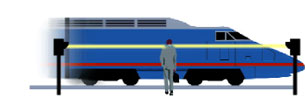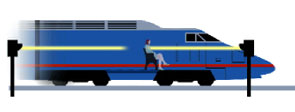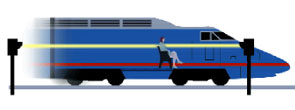|
Length
Two observers, one onboard a train and the other standing outside it, try to measure the train's length by comparing it to a measured length of track. A light at the forward end of the track will flash when the front of the train reaches it; the light at the back will flash when the back of the train passes. As shown below, the outside observer, standing at the midpoint of the track, sees both lights come on simultaneously and concludes that the train is exactly as long as the section of track.
The onboard passenger reaches a very different conclusion, as shown in three steps at right. The train's motion carries the passenger forward to meet the light coming from the forward signal. Because she receives that light before any light arrives from the signal behind her (top), the passenger concludes that the front end of the train has reached the forward mark on the track before its back end has passed the rear mark; therefore, the train is longer than the track (middle). Indeed, the passenger's estimate of the train's length increases until she finally perceives the flash from the rear light (bottom). 
| 

 |
|
tall, uneven staircase. It can hop one step or many steps at a time, going either up or down. However, it cannot stop in midair between two steps. That's one of the odd rules that physicists discovered for electrons in energized atoms. They can orbit  only at certain "levels" around the atom, and at no others. only at certain "levels" around the atom, and at no others.
Even stranger, we can never know exactly where the electron-kangaroo is or how much energy it contains. The more precisely we try to measure it, the more uncertain it becomes. This inability to measure the exact speeds and positions of subatomic particles at the same time is called the Heisenberg Uncertainty Principle  , named for the German physicist Werner Heisenberg , named for the German physicist Werner Heisenberg  . It means that electrons are not bits that we can pinpoint in space, like motes of dust; rather, they are statistical blurs. Electrons and the tiny units of light energy called photons . It means that electrons are not bits that we can pinpoint in space, like motes of dust; rather, they are statistical blurs. Electrons and the tiny units of light energy called photons  act like particles in some circumstances and like waves in others, a final oddity that defies rational explanation. act like particles in some circumstances and like waves in others, a final oddity that defies rational explanation.
To account for all of this, scientists developed a theory called quantum mechanics  . It sounds like science fiction, but one experiment after another has confirmed the ability of quantum mechanics . It sounds like science fiction, but one experiment after another has confirmed the ability of quantum mechanics  to predict the behavior of matter. Despite its impressive string of successes, Einstein found quantum mechanics to predict the behavior of matter. Despite its impressive string of successes, Einstein found quantum mechanics  so intellectually unpleasant that he spent the last decades of his life trying to disprove it. Even today, this subatomic world could not be more alien to our senses. Nevertheless, we depend on so intellectually unpleasant that he spent the last decades of his life trying to disprove it. Even today, this subatomic world could not be more alien to our senses. Nevertheless, we depend on  quantum mechanics quantum mechanics  to learn the properties of objects halfway across the universe. Much of our modern technology, from photocopiers to laser pointers to supercomputers, relies on quantum mechanics to learn the properties of objects halfway across the universe. Much of our modern technology, from photocopiers to laser pointers to supercomputers, relies on quantum mechanics  . But what are the exact speeds and locations of the electrons and photons . But what are the exact speeds and locations of the electrons and photons  in these devices? Heisenberg knew the answer: We can never know. in these devices? Heisenberg knew the answer: We can never know.
The Universe GOES 'ROUND
A more tangible component of motion that appears everywhere is rotation. We could supplement our summary of the cosmos, "Everything moves," with a companion statement, "Everything spins." This applies to electrons and atoms, eddies in a stream  , storms in the atmosphere , storms in the atmosphere  , asteroids , asteroids  and planets, stars, and entire galaxies. and planets, stars, and entire galaxies.
At first, this rule of thumb might not seem obvious. Anything near at hand that you could set twirling--a coin, a top, an egg--seems eager to grind to a halt fairly quickly. That's because friction  resists the motion of a spinning object when it touches something else. But once you reduce friction resists the motion of a spinning object when it touches something else. But once you reduce friction  , as Galileo did for motion in a straight line, the persistence of rotation becomes clear. , as Galileo did for motion in a straight line, the persistence of rotation becomes clear.
One easy way to demonstrate this is to spin in your desk chair, preferably when your boss or teacher isn't looking. A swift sideways push off any handy surface sends you whirling. But the exhilaration is short lived. Friction  between the spinning metal post and the stationary base of the chair converts the rotational energy into heat, and you slow to a light-headed stop. If you coat the post with some oil, you might spin two or three times longer. The thin layer of slippery liquid lowers the friction between the spinning metal post and the stationary base of the chair converts the rotational energy into heat, and you slow to a light-headed stop. If you coat the post with some oil, you might spin two or three times longer. The thin layer of slippery liquid lowers the friction  but doesn't eliminate it entirely. but doesn't eliminate it entirely.
Now think of a spinning basketball. If you plunk the ball into a tub of water and spin it, the drag from countless water molecules on the bottom of the ball quickly slows it down. But if you are dexterous enough to spin the ball on your finger, you can reduce (continued)
|

